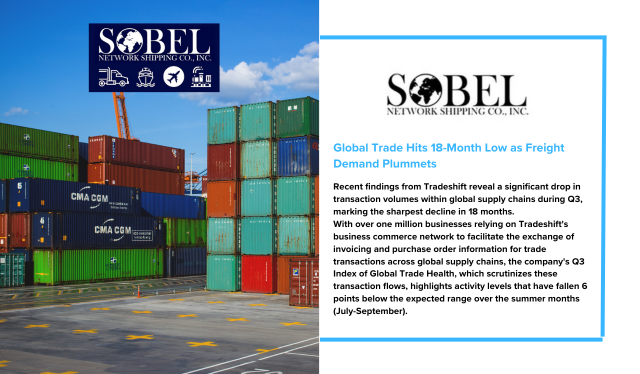Recent findings from Tradeshift reveal a significant drop in transaction volumes within global supply chains during Q3, marking the sharpest decline in 18 months.
With over one million businesses relying on Tradeshift’s business commerce network to facilitate the exchange of invoicing and purchase order information for trade transactions across global supply chains, the company’s Q3 Index of Global Trade Health, which scrutinizes these transaction flows, highlights activity levels that have fallen 6 points below the expected range over the summer months (July-September).
Decline in Global Goods Demand
The plummeting demand for manufactured goods is an unequivocal factor contributing to the recent deceleration:
- Manufacturing activity dipped 9 points below the baseline during Q3.
- Freight demand softened, falling 6 points below the anticipated level.
- Retail activity also experienced a decline, dropping 6 points below the anticipated range.
The Eurozone and China Bear the Brunt
Export-oriented markets, such as China and the Eurozone, are grappling with the brunt of the downturn in goods demand. Trade activity across the Eurozone nosedived to 9 points below the expected level in Q3, compared to a 3-point deficit in the preceding quarter. In China, transaction volumes dipped 6 points below the baseline level, marking the first time activity has entered contraction territory this year.
In the UK, activity mirrored the global trend as transaction volumes slowed to 6 points below the baseline.
The US Remains a Growth Outlier
While US trade activity did soften during Q3, the rate of decline was considerably milder than in other markets. Transaction volume growth decreased to 3 points below the expected level in Q3, after surging to 3 points above the baseline in the prior quarter.
James Stirk, Tradeshift’s interim CEO, remarked, “Globally, we’re witnessing mounting evidence of an economy that’s preparing to land. Traditional manufacturing powerhouses across the Eurozone and China are experiencing more turbulence than the US, where a robust domestic market suggests a softer landing is more likely.”
Emerging Markets Benefit from Supply Chain Diversification
Although the drop in trade activity has been consistent across most major economies, some are reaping the rewards of a supply chain reconfiguration that has gained momentum since the pandemic.
Tradeshift’s data highlights Vietnam, in particular, benefiting from an accelerated ‘China+’ production policy among Western companies, with transaction volumes rising seven times faster than the global average over the past year.
India, Malaysia, and Mexico are also experiencing benefits from supplier diversification, with activity levels in each country increasing at three times the global average over the past year.
Stirk noted, “Global trade has appeared more localized in 2023, but a new form of globalization is also beginning to emerge, and new stars are on the rise. To thrive in this environment, businesses will need to establish new relationships in new jurisdictions. For supply chain operators, bolstering the digital connectivity between trading partners will play a pivotal role in ensuring a seamless transition.”


